
GVB is the municipal public transport operator for Amsterdam, the capital of the Netherlands, operating metro, tram, bus and ferry services in the metropolitan area of Amsterdam.

The Prinsengracht is a 3.2-kilometer (2.0 mi)-long canal that runs parallel to the Keizersgracht in the center of Amsterdam. The canal, named after the Prince of Orange, is the fourth of the four main canals belonging to the canal belt.

The Noorderkerk is a 17th-century Protestant church in Amsterdam, The Netherlands. The Noorderkerk is located along Prinsengracht canal, on Noordermarkt square. The church is used for Dutch Reformed Church services and is also used regularly for classical music concerts.
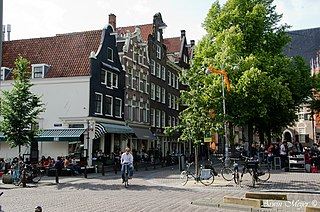
The Noordermarkt is a square in the Jordaan neighborhood of Amsterdam in the Netherlands. The square is dominated by the 17th-Century Noorderkerk church, and is lined by cafés and restaurants. Markets are held on the square every Monday. On Saturdays, a popular organic farmer's market is held on the square. On Mondays a market is also held in the adjacent Westerstraat street.

Amsterdam, capital of the Netherlands, has more than 100 kilometers (62 mi) of grachten (canals), about 90 islands and 1,500 bridges. The three main canals, dug in the 17th century during the Dutch Golden Age, form concentric belts around the city, known as the Grachtengordel. Alongside the main canals are 1550 monumental buildings. The 17th-century canal ring area, including the Prinsengracht, Keizersgracht, Herengracht and Jordaan, were listed as UNESCO World Heritage Site in 2010, contributing to Amsterdam's fame as the "Venice of the North".
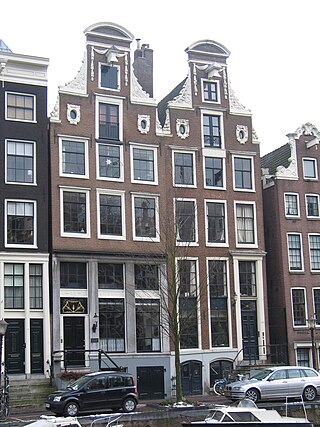
A canal house is a house overlooking a canal. These houses are often slim, high and deep. Canal houses usually had a basement and a loft and attic where trade goods could be stored. A special beam or pulley installation would be located in the attic to hoist up valuable goods, like spices, cotton, or heavier stuff like cocoa. In recent times, the pulleys are only used for moving furniture.

De Negen Straatjes is a neighbourhood of Amsterdam, Netherlands located in the Grachtengordel, a UNESCO World Heritage Site.
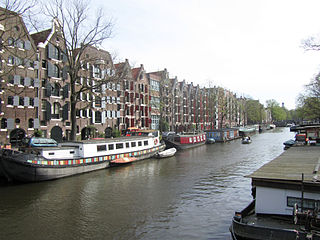
The Brouwersgracht is a canal in Amsterdam that connects the Singel with the Singelgracht. The canal marks the northwestern border of the Grachtengordel. Between the Prinsengracht and the Singelgracht the Brouwersgracht forms the northern border of the Jordaan neighborhood.

Amsterdam-Centrum is the inner-most borough and historical city centre of Amsterdam, Netherlands, containing the majority of the city's landmarks. Established in 2002, Amsterdam-Centrum was the last area in the city to be granted the status of self-governing borough. The borough is 8.04 km2 and covers the UNESCO-listed Amsterdam canal belt. In 2013, the borough had approximately 85,000 inhabitants, who on average had the second-highest income per household in the city and one of the highest in the country.
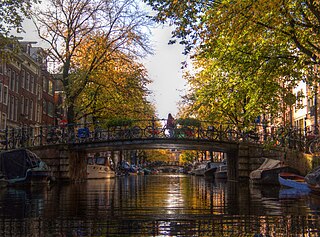
The Egelantiersgracht in Amsterdam is a canal in the Jordaan neighbourhood in the Amsterdam-Centrum borough. The canal lies between the Prinsengracht and the Lijnbaansgracht.

The Rozengracht is a street in the Jordaan neighbourhood of Amsterdam. It runs between the Prinsengracht at the Westermarkt and the Singel canal at De Clercqstraat. The name means "Rose canal".

The Passeerdersgracht is a short canal in Amsterdam, the Netherlands, that connects the Prinsengracht with the Lijnbaansgracht. The canal is the southernmost in the Jordaan neighbourhood and borders the west part of the Grachtengordel.

The Bloemgracht is a canal in the Jordaan district of Amsterdam, the Netherlands. It connects the Prinsengracht with the Lijnbaansgracht and runs between and parallel to Nieuwe Leliestraat and Bloemstraat in the Amsterdam-Centrum district. The canal is named after the bulwark "de Bloem", later called "Rijkeroord". From 1614 a windmill was located here, but it was moved to Haarlemmerweg in 1878.

The Elandsgracht is a street and former canal in Amsterdam, the Netherlands. It runs between the Prinsengracht and the Singelgracht in the Jordaan neighborhood of the Amsterdam-Centrum district. Bridge 169 over the Singelgracht and Bridge 107 over the Lijnbaansgracht connect the Elandsgracht in the direction of the Kinkerstraat. The Elandsgracht is in the west of the Grachtengordel. The Elandsstraat runs parallel to the Elandsgracht. There are houses, shops, cafés and restaurants on the former canal, with parking spaces in the middle.
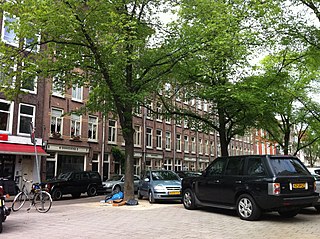
The Lindengracht is a street and former canal in Amsterdam. It is in the Jordaan neighborhood of the Centrum district just west of the canal belt. The canal was back-filled in 1895. It connected the Brouwersgracht with the Lijnbaansgracht. The Eerste Lindendwarsstraat and Tweede Lindendwarsstraat are side streets. Lindenstraat runs parallel to the Lindengracht.

The Anjeliersgracht is a former canal in the Jordaan neighborhood of Amsterdam. After being backfilled in 1861, it is now Westerstraat.

The Westerstraat is a major street in the Jordaan, a neighborhood of Amsterdam, in the Netherlands. The street was created by the filling in of the Anjeliersgracht. It runs from the Noordermarkt to the Marnixstraat. Besides residential homes and shops, including a supermarket, there are restaurants and cafes.
The following is an alphabetical list of articles related to Amsterdam. Amsterdam is the capital city of the Netherlands.

























